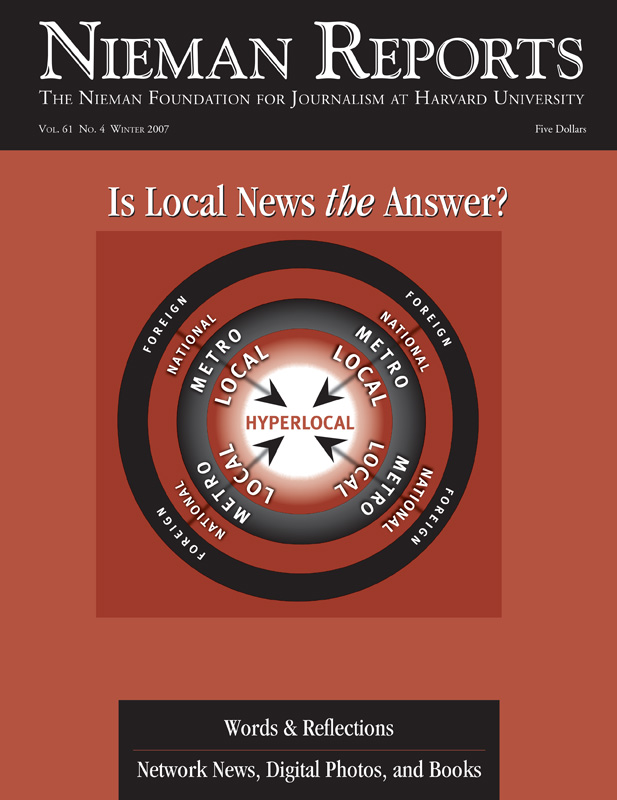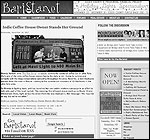People are talking local. And what they are talking about isn’t coming from their local newspaper but because they clicked on a story delivered to their e-mail or on a local Web site’s homepage. What they find there, they talk about in real time. This Web to water cooler connection is happening throughout the country—because of what a lot of folks call “placeblogs,” Web sites with an intense, some say “hyperlocal,” focus on what’s going on close to home.
As managing editor and co-owner of Baristanet.com, a hyperlocal online news site based in Essex County, New Jersey, I’ve watched the conversation and the medium grow during the past three and a half years. Perhaps because in my day job I work as an editor at the New York Daily News, I’ve been invited to talk about what we do at Baristanet with newspaper editors and entrepreneurs from around the country as they both look for ways to start similar successful ventures.
Big news stories are everywhere. Anyone with an Internet connection can get access to them from a variety of Web sites. So it’s not surprising that there’s a lot of attention being focused on getting the stories everyone else doesn’t have. Zeroing in on readership by creating unique local content in a variety of forms is what we do at Baristanet.
The Local Formula
To do local, it is essential to know local. I’ve gotten to know our readership, a dedicated, growing and eclectic group of folks who visit our site to the tune of 7,000 hits a day. When I say “gotten to know” I’m talking about the keen attention we pay to our readers. When bigger news operations attempt to create sites for local content, I’ve noticed that the level of attention paid to readers isn’t as high. How can it be? What happens often is that the news outlet creates a template and hopes that citizen journalists or local “mayors” arrive and magically start to feed it content.
Nearby, the local newspaper, The Montclair Times, has a main Web site on which articles from the morning paper appear online the same day. It has no interactive component, and thus no options for commenting, nor any forums. Our Web site benefits from this limited Web presence of the Times. In the past year, the newspaper launched “My Montclair,” a separate online community page. With advertisements in their paper, they encouraged readers to contribute photos and stories. These ads promoted this by telling readers how easy this is to do. But when we look at “My Montclair” today, we can see that one contributor has essentially hijacked the page by using it as a platform for his own rants.
When no effort at personal engagement is extended by those building the site, the online experiment is destined for dullness. With local news, dullness means death. Traditional community newspapers conjure up images of council meetings, public notices, and the occasional feel-good picture of do-gooders. Published once a week, the news is stale by the time it reaches residents. With a major story—a natural disaster or a power outage—what lands on the doorstep is no longer news at all. People accepted this because until now the local paper was the only game in town, churning out the same tired formula of news, enjoying a captive audience, and dominating local advertising.
Technology—and new media derived from it—has changed the game. Entrepreneurial sites like Baristanet, Hoboken 411, and others around the country are playing hardball. Baristanet routinely scoops the local papers and takes a healthy chunk of ad revenues away from both town and regional papers. More importantly, hyperlocal news sites like ours are bringing the personality of a community to the news by letting residents have a much more active role in dictating what is news. That they cover the news, too, gives it an even more personal touch.
Readers of local news now demand timeliness and immediacy of its delivery. In the age of Internet immediate gratification, who wants to look at 4th of July parade photos on July 11th? Immediacy of delivery translates into more people coming to our site: Traffic spikes to 12,000 on days we cover a breaking news story such as a bank robbery. No waiting until Thursday to find out what’s happening on Monday.
Community Voices
Participatory journalism—with enhanced opportunities for dialogue—benefits those who live in the community it serves. More eyes on what local officials do, or fail to do, leads to improving the community’s watchdog accountability as residents now demand greater transparency. They also use our site to spearhead efforts to solve community problems. Local election coverage has improved, teardowns of historic homes have been prevented, and platforms for public engagement are open to community members who might not have had a voice in the past. In real time news sharing, we inform residents about traffic, weather and crime. And to create buzz for an issue, a cause, or a policy change some might disagree with—just to get word out about what’s important to them—residents in Montclair, Glen Ridge, and Bloomfield, which are the areas we serve, increasingly turn to Baristanet.
Providing a home for local content isn’t just about relaying news. It’s about capturing the unique voice and flavor of a community. Personalized local content is just as important as having the barista at the local coffee shop know just how you like your morning cup. By us getting to know the voices, buzz and language of these communities and inviting residents to use their voices, we’ve laid the foundation for a solid readership. For many, the site—with its polls and survey, book clubs and calendars, videos and podcasts—is now as necessary as the first cup of coffee each morning.
Making Baristanet a viable success happened without benefit of venture capital money or a sophisticated infrastructure. We started it as two journalists with a desire to make local news entertaining. And while the Web tools to do this are easy to find, the toughest thing to find is the unpaid time each day to devote to it. Fortunately, in the past year my founding partner and I have been able to draw a consistent salary from Baristanet, and we are also able to pay our staff—two writers, a designer, and a part-time tech consultant, as well as our accountant. Based on current revenue, each of us could quit our day jobs, but we enjoy the security of having both, the creativity of doing this, and the juggling of more than one pursuit.
Once we got the site going, we found a readership who embraced it and made it their home. To initially get people to notice Baristanet, we created swag (Frisbees, beach balls, and other giveaways) to distribute at outdoor festivals and community events. We also compiled and added to a healthy e-mail address list of key people in the community. We did a lot of interaction with local police—sent over some lunches to them—as well as city council members. We went onto existing area user groups and tried to get noticed there. Our big discovery was that the most effective method was through word of mouth.
In many ways, keeping Baristanet, a 24/7 operation, going has been probably the most fun I’ve had as a journalist. In my day job as special sections editor at the New York Daily News, I do news and features much in the way I was taught at New York University’s School of Journalism. On Baristanet, we balance straight news pieces (crime and other news of a serious nature) with aggregated news, polls and opinion-style pieces. It’s an approach to local content more in the mode of a columnist/provocateur serving up news with a generous helping of opinion and humor.
Local news lends itself to this less serious tone. It’s finding out which city counselor blew his or her stack last night at the meeting. It’s having a live chat with an elected official or, more importantly for a lot of our readers, commenting on the idiocy of how local officials handled a certain problem. One town has had a proliferation of Canada geese at a park, causing complaints from residents who found the grounds covered with droppings. A firm was hired to scare the geese away with fake coyotes, fake dead geese, scary balloons, and other equally absurd decoys. When these methods failed, the town—declaring that it had exhausted every measure—hired someone to kill the geese. Readers came to our site and furiously debated this issue rather than writing letters to the editor and waiting for the local paper to comment.
Local content isn’t static. It’s about a community—its people and places, its sensibilities and shared experiences—being its own news. It might involve a plea to find a lost pet, or a review of a local restaurant, but it all involves community building. By sending a digital photo or getting a news tip to us via e-mail, a person becomes the force that launches a new story. By recognizing and validating the reader’s role in breaking news, we create a loyal and active readership, which over time does more of the reporting work that likely began with those who conceived the site.
Local content won’t thrive—or even survive—when those who receive it are set apart from the business of creating it. Put up fences to corral such enterprise on a separate, non-news site, and the endeavor is doomed to fail. Local readers shape and make their news. Ignore them at your peril, for if they are ignored, they’ll quickly move on—with the click of their mouse.
Liz George is special sections editor at the New York Daily News and the managing editor and co-owner of Baristanet.



